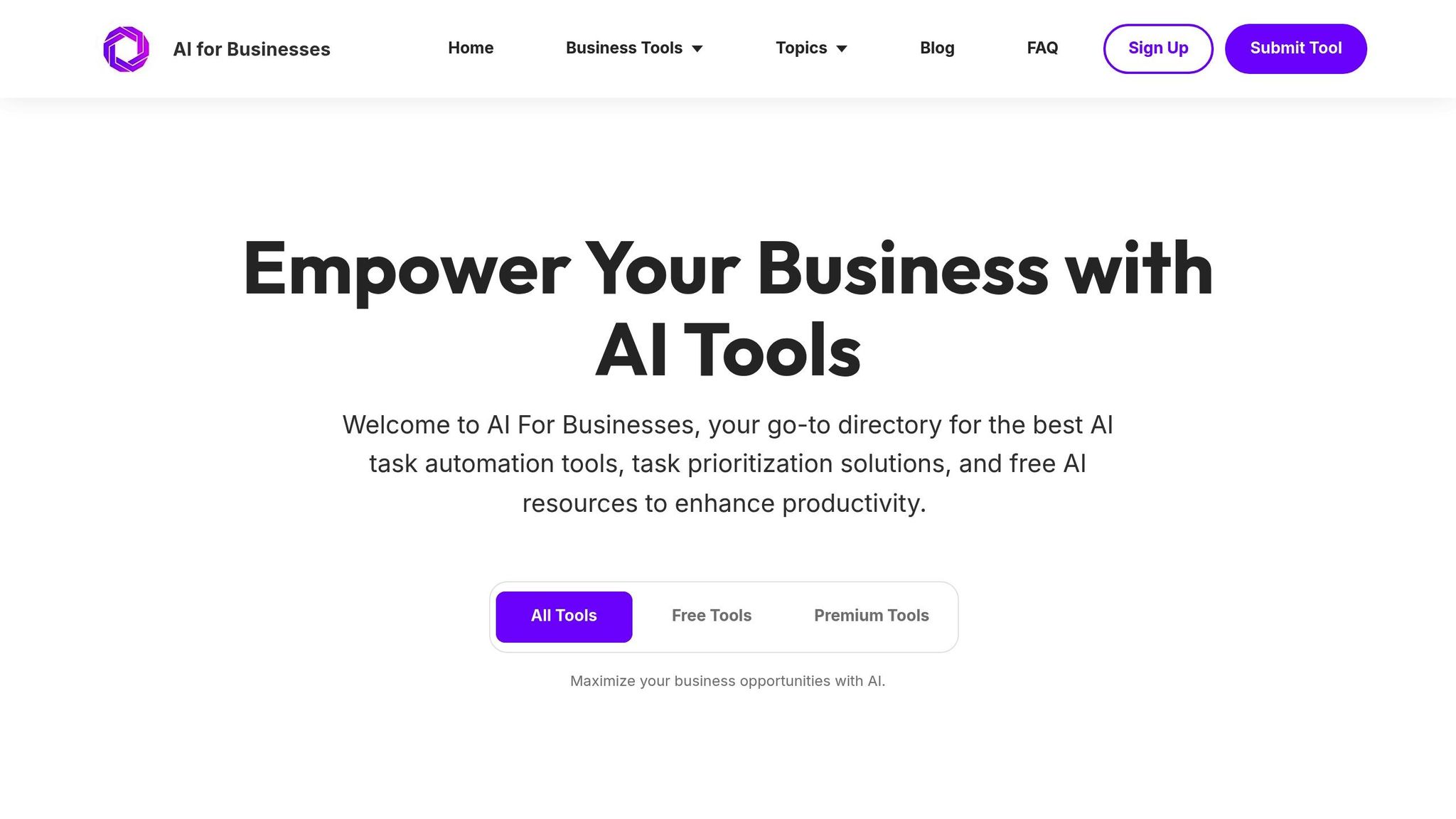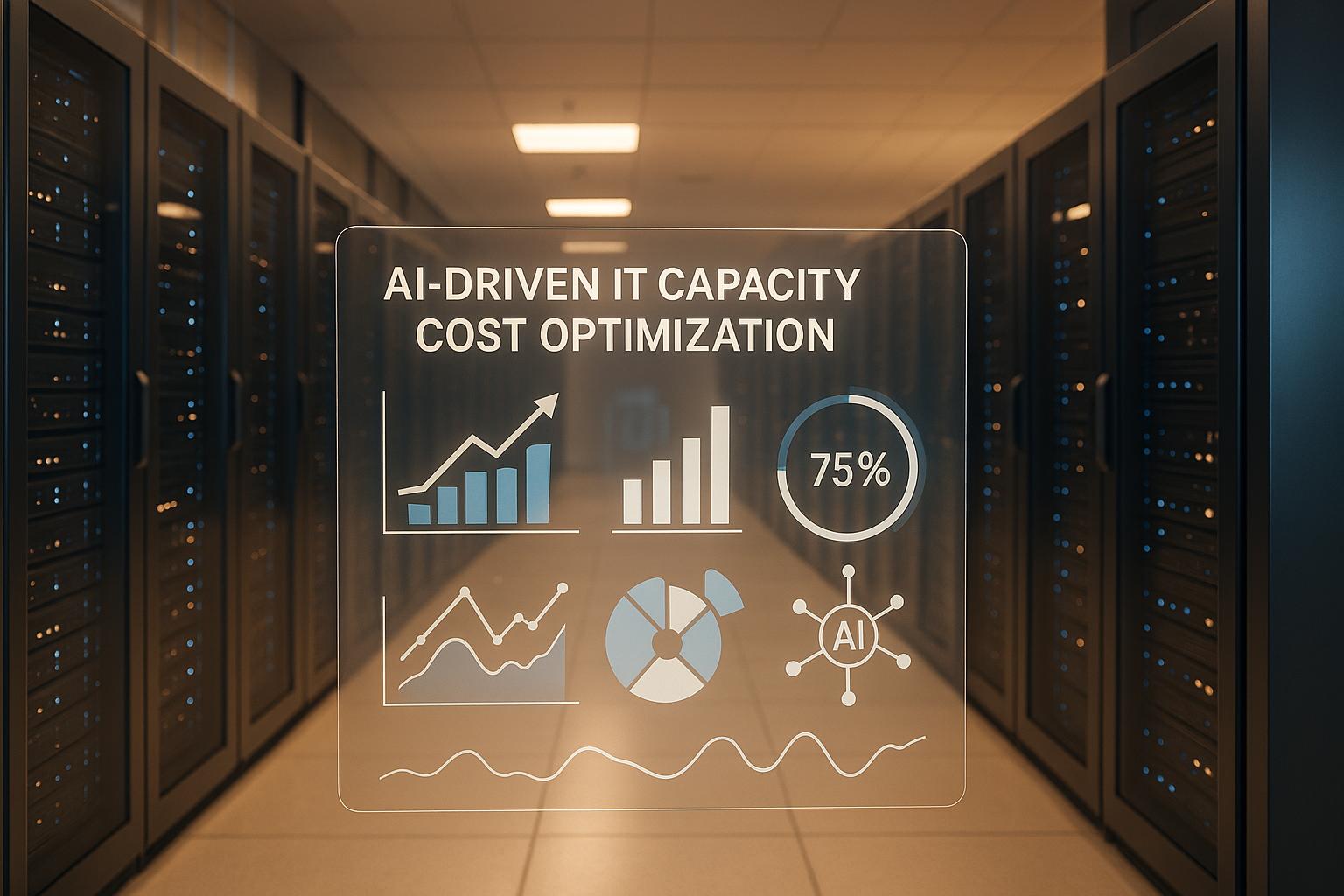AI-driven data warehousing transforms how businesses manage, analyze, and use data. By integrating machine learning, these systems automate tasks like data cleaning, anomaly detection, and predictive analytics - saving time and improving decision-making. Small and medium-sized businesses (SMEs) benefit the most, gaining access to real-time insights and enterprise-level analytics without requiring technical expertise.
Key Takeaways:
- Why It Matters for SMEs: Automates data management, integrates with tools like CRMs and e-commerce platforms, and delivers real-time insights.
- Building the Framework: Start by defining business goals, auditing data sources, and choosing the right platform (e.g., Snowflake, Google BigQuery, or Databricks).
- Automation with AI: Use AI for tasks like ETL/ELT, error detection, and no-code data integration tools (e.g., Fivetran, Zapier).
- Improving Data Quality: AI ensures accurate, compliant data with automated checks and governance tools.
- Real-Time Analytics: AI enables instant insights and predictive analytics for customer behavior, inventory, and risk assessment.
Next Steps: Begin small with a focus on a single use case, choose scalable tools, and train your team to use AI effectively.
Building Your AI-Driven Data Warehouse Framework
Setting Business Goals and Data Requirements
Before diving into platform selection, take a step back and clearly define your business goals and data needs. This step sets the stage for everything else, from budgeting to the AI tools you'll eventually rely on.
Start by pinpointing your main objectives. Are you aiming to improve customer retention, fine-tune inventory management, or sharpen your financial forecasting? Each of these goals comes with its own data and AI demands. For example, reducing customer churn might require integrating data from customer interactions, purchase histories, website activity, and social media.
Next, audit your data sources. Identify where your data lives, what format it's in, how often it updates, and who has access to it. This inventory will give you a sense of the integration work you'll need to tackle.
Another critical factor is understanding your data's volume and speed requirements. A retail business processing 10,000 transactions daily will have vastly different needs than a consulting firm managing 100 client interactions a month. These patterns will guide you in choosing the right storage capacity and processing power for your data warehouse.
Don’t overlook compliance requirements. If you're in a regulated industry like healthcare or finance, your data warehouse must meet standards like HIPAA or SOX. These regulations will influence both your platform choice and your data governance policies.
Once you've nailed down your goals and requirements, you're ready to choose a platform that aligns with your needs.
Selecting AI-Powered Platforms
Your platform will be the backbone of your AI-driven data warehouse, so it’s crucial to pick one that matches your current needs while leaving room for growth.
Snowflake is a great option if you're looking for automatic scaling and easy integration with AI tools. It allows you to dive into advanced analytics as your business evolves.
Google BigQuery is particularly appealing for businesses already using Google Workspace or Google Cloud. Its BigQuery ML feature lets you build and run machine learning models with standard SQL queries, making AI more accessible to team members who aren’t data science experts. Plus, its serverless architecture simplifies infrastructure management.
Databricks shines when it comes to developing and deploying sophisticated AI models. While it may require a bit more effort to learn, it offers the flexibility you need to create custom AI solutions. Its collaborative notebooks also make it easier for teams to work together on complex analytics projects.
Whatever platform you choose, make sure it integrates seamlessly with tools your business already uses, like QuickBooks, Salesforce, Shopify, or HubSpot. This minimizes the need for custom development and keeps things running smoothly.
Finally, pay attention to pricing models. Snowflake charges separately for compute and storage usage, while BigQuery uses a pay-per-query approach. Take a close look at your expected usage to find the most cost-effective option for your business.
Planning for Growth and Future AI Updates
Once you’ve selected your platform, focus on building a system that can grow with your business and adapt to new AI capabilities.
Design your architecture to be modular, so you can add new features or upgrade AI tools without overhauling everything. For instance, you might start with basic automated reporting and later incorporate predictive analytics as your team gets more comfortable with AI.
Plan for data growth. Many businesses underestimate how quickly their data scales. A company might start with 1 GB of data per month and quickly grow to 10 GB as operations expand. Cloud-based solutions are typically better equipped to handle this kind of growth compared to on-premises systems.
Invest in your team’s skills. As your operations shift from basic SQL queries to more complex AI tasks, training or choosing platforms with user-friendly interfaces can make the transition smoother.
Put version control systems in place to track changes in your data models, AI algorithms, and business rules. Detailed documentation will help you understand how these changes impact performance and keep your system running efficiently.
Lastly, allocate funds for ongoing platform updates and new AI features. Staying up-to-date with the latest tools and capabilities can give you a competitive edge in your industry.
Supercharging AI with Scalable Data Solutions in Microsoft Fabric's Data Warehouse

Automating Data Integration and Processing with AI
Using AI to manage your data integration processes can significantly streamline workflows and improve accuracy. With AI handling tasks like ETL (Extract, Transform, Load), no-code setups, and pipeline optimization, businesses can focus on insights rather than manual data management.
Setting Up AI-Powered ETL/ELT Solutions
AI-powered ETL/ELT tools simplify data workflows by detecting patterns, recommending transformations, and adapting to new data formats automatically.
Take Fivetran, for example. It uses machine learning to detect schema changes in systems like Salesforce or e-commerce platforms and updates your data pipelines automatically. This ensures your pipelines stay functional without constant manual adjustments.
Similarly, Stitch Data (part of Talend) focuses on API-based integrations. It handles challenges like rate limiting, renewing authentication, and converting data types seamlessly, making it easier to manage data from multiple sources.
For businesses working with IoT devices, AI can filter and process specialized data. Imagine a manufacturing company with temperature sensors generating readings every second. Instead of storing every single reading, AI can calculate hourly averages, saving storage space and simplifying analysis.
Customer database integration also benefits from AI. By using fuzzy matching algorithms, AI can link customer records across platforms like CRMs, email marketing tools, and e-commerce systems - even when names or details don’t match perfectly. Over time, AI learns and improves, boosting accuracy with every use.
Using No-Code Tools for Quick Data Setup
When custom integrations feel like overkill, no-code platforms provide a fast and efficient alternative. These tools use visual interfaces and pre-built connectors to integrate data without requiring programming skills.
Zapier, for instance, has expanded its capabilities to include AI-driven data transformations. It can clean incoming data, standardize formats, and even categorize customer support tickets by sentiment and urgency. This ensures tickets are routed to the right teams quickly and efficiently.
Microsoft Power Automate, integrated with Office 365, is perfect for businesses already in the Microsoft ecosystem. Its AI Builder extracts data from documents and images automatically. A real estate company, for instance, could use it to pull property details from listing photos and populate their database without manual input.
For more complex workflows, Bubble offers advanced no-code capabilities. While it has a steeper learning curve, it’s ideal for businesses needing multi-step transformations or intricate business logic that would typically require custom development.
The main advantage of no-code tools is their speed. What might take weeks with custom development can often be set up in just a few hours or days. This makes it easier for small and medium-sized businesses to experiment with different approaches and adapt quickly. However, these tools are best suited for standardized data sources. If your systems are highly customized or your data is in unusual formats, you may still need technical expertise to fill the gaps.
Improving Data Pipelines for Better Performance
AI-driven monitoring tools can transform how you manage data pipelines by identifying bottlenecks, predicting failures, and suggesting optimizations before issues arise.
DataDog is a great example. It uses AI to learn your typical data flow and alerts you when something deviates from the norm. For instance, it can differentiate between seasonal sales spikes and actual system issues that need attention.
AI also enhances pipeline performance optimization. These tools analyze your workflows and suggest improvements, such as tweaking batch sizes, reordering transformation steps, or redistributing workloads to avoid peak-hour charges.
One of AI’s standout features is error prediction and prevention. Instead of reacting to failures, AI can detect warning signs like slower processing times or unusual data patterns. This helps prevent disruptions and ensures smoother operations.
For cost management, AI tools monitor cloud resource usage and recommend adjustments to save money. They might suggest running processes during off-peak hours or flagging unused resources for scaling down.
Automated recovery is another game-changer. AI can restart failed processes, retry data loads with adjusted settings, or switch to backup sources when primary ones fail - all without human intervention. This minimizes downtime and keeps your data flowing.
The best strategy combines proactive monitoring with automated responses. Critical issues can trigger alerts for human review, while AI handles routine hiccups like minor connection issues or data inconsistencies.
Regular performance reviews powered by AI insights can reveal long-term trends. For example, you might identify recurring issues with specific data sources or bottlenecks in your transformation steps as your data volume grows. These insights guide decisions about upgrading infrastructure or refining processes, ensuring your pipelines stay efficient as your business scales.
Improving Data Quality and Governance with AI
Maintaining top-tier data quality and robust governance is essential for getting the most out of an AI-driven data warehouse. However, as businesses expand, keeping data accurate and compliant becomes more complex. This is where AI steps in, simplifying these challenges by automating quality checks, enforcing governance policies, and offering continuous monitoring - tasks that manual processes often struggle to keep up with.
Automating Data Quality Checks with AI
AI takes data quality monitoring to a whole new level, far beyond simple validation rules. These advanced systems analyze historical trends to understand data patterns and flag anomalies that traditional methods might miss. For example, AI can spot sudden spikes in costs or unexpected drops in record counts, which could point to deeper issues. Duplicate detection algorithms are another game-changer, identifying records that represent the same entity even when there are minor differences in spelling or formatting.
Real-time validation is another major advantage. AI can instantly check incoming data against multiple criteria, catching errors before they affect analytics or decision-making. This proactive approach ensures data quality remains high, laying the groundwork for stronger governance practices.
AI-Powered Governance and Compliance Management
AI doesn’t just stop at improving data quality - it also plays a critical role in governance and compliance. Modern tools use AI to enforce data policies and keep detailed audit trails. For instance, AI can automatically classify sensitive information by analyzing its content and patterns, then apply access controls based on privacy laws or retention policies. Behavioral analytics add another layer of security by monitoring how users interact with data and flagging unusual access patterns that might indicate misuse.
Policy automation is another key feature. AI can classify new data entries, set retention schedules, and control access according to pre-set rules. It can also map data relationships from origin to transformation through lineage tracking, making compliance reporting much easier. Plus, automated dashboards and alerts keep teams informed about potential policy violations, allowing them to address issues before they escalate.
Setting Up Data Stewardship with AI Support
AI-enhanced data stewardship fosters a collaborative environment where machine intelligence works hand-in-hand with human expertise to maintain data quality. Automated profiling tools regularly scan datasets, providing insights into data distribution, quality metrics, and potential problems. When anomalies occur, AI learns what’s normal and alerts stewards, enabling faster and more precise responses.
AI also streamlines workflows by assigning issues to the right team members based on their expertise and workload. Smart recommendations, drawn from past resolutions, guide stewards toward effective solutions. Dashboards offer real-time visibility into data health, prioritizing issues based on their potential business impact. Over time, as AI learns from steward actions, it becomes better at addressing recurring problems. Cross-system validation ensures consistency across multiple data sources, adding another layer of reliability.
This combination of automated monitoring and human oversight creates a strong framework for data stewardship. By blending proactive machine intelligence with reactive human expertise, businesses can achieve a balance that keeps data quality and governance at their best.
sbb-itb-bec6a7e
Using AI for Real-Time Analytics and Predictions
Once you've established strong data quality and governance practices, the next step is turning that clean, structured data into insights that drive real business decisions. With the right tools, your data warehouse can evolve into a hub of intelligence, enabling real-time analytics, predictive insights, and actionable strategies. Together, these capabilities can give small and medium-sized enterprises (SMEs) the agility to stay competitive in fast-paced markets.
Setting Up Real-Time Data Processing
Real-time data processing allows businesses to react instantly to changes as they happen. Modern AI systems continuously process streaming data, identifying patterns and sending alerts the moment something noteworthy occurs. This is especially useful for monitoring customer activity, managing inventory, or catching operational issues early.
AI-powered stream processing engines can handle thousands of data points per second. Imagine an e-commerce platform tracking user behavior in real time. If AI detects something unusual - like a sudden rise in cart abandonment or a slowdown in the payment system - it can immediately flag the issue for a quick response.
To make this work efficiently, intelligent pipelines filter out unnecessary data, ensuring you only focus on what matters. AI algorithms can tell the difference between routine updates and events that require immediate attention, preventing information overload. These systems also scale processing power automatically based on data flow, keeping costs in check while maintaining performance.
Event-driven architectures are another key piece of the puzzle. These systems respond instantly when specific triggers occur - like a customer making a big purchase or a supply chain hiccup. AI can then kick off workflows, send alerts, or update dashboards in real time. This responsiveness helps businesses seize opportunities or resolve issues before they grow into bigger problems.
Applying Predictive Analytics for Business Growth
Once real-time data is processed, predictive analytics steps in to forecast what’s likely to happen next. AI models excel at uncovering patterns and relationships in data that might not be obvious to the human eye, making predictions more precise and actionable. These insights help businesses allocate resources wisely, anticipate customer needs, and uncover new growth opportunities.
For example, demand forecasting uses data like seasonal trends, customer behavior, and market conditions to predict future sales. This allows businesses to fine-tune their inventory, marketing plans, and staffing needs. And because these models learn from fresh data, their accuracy improves over time.
Customer lifetime value prediction is another powerful tool. By analyzing purchase history, engagement trends, and demographics, AI can pinpoint which customers are most likely to provide long-term value. Businesses can then focus their retention strategies on these high-value customers while exploring upselling or cross-selling opportunities.
When it comes to retaining customers, churn prediction models are invaluable. By examining usage patterns, support interactions, and payment histories, AI can identify customers at risk of leaving weeks - or even months - before they do. This early warning system gives businesses time to implement targeted retention efforts, potentially saving significant revenue.
AI also enhances risk assessment. Whether it’s evaluating credit applications, predicting equipment failures, or assessing supplier reliability, predictive models analyze massive amounts of historical data to highlight risks that traditional methods might miss. This enables smarter, more informed decision-making while reducing potential losses.
Using Prescriptive Analytics for Action Plans
While predictive analytics tells you what’s likely to happen, prescriptive analytics takes it a step further by recommending specific actions to achieve your goals. This advanced capability combines prediction with optimization, offering clear guidance on the best steps to take. For SMEs with limited resources, it’s a game-changer.
Take dynamic pricing optimization, for instance. AI can analyze factors like competitor pricing, demand trends, inventory levels, and customer sensitivity to suggest pricing strategies in real time. These recommendations aim to maximize revenue while keeping your offerings competitive.
Resource allocation optimization is another area where prescriptive analytics shines. AI can analyze workloads, employee skills, and project requirements to recommend staffing adjustments. In manufacturing, it might suggest production schedules that reduce waste while meeting delivery deadlines. Service-based businesses can use it to assign technicians more efficiently, cutting travel time and boosting customer satisfaction.
In marketing, campaign optimization uses prescriptive analytics to recommend the best strategies for reaching different customer segments. AI evaluates past campaign performance, customer preferences, and market conditions to suggest actions like adjusting ad spend, refining email timing, or tailoring content to specific audiences.
Supply chain optimization also benefits from prescriptive analytics. AI can recommend everything from supplier choices and inventory reorder points to shipping routes that cut costs without sacrificing service quality. During disruptions, it can even generate alternative plans to minimize the impact on operations.
One of the most powerful aspects of prescriptive analytics is its ability to simulate "what-if" scenarios. Businesses can explore the potential outcomes of various decisions before committing resources, reducing risk and enabling more confident, data-driven choices. This capability helps organizations make smarter moves that support long-term growth.
AI for Businesses as Your Tool Resource

When it comes to AI-powered data warehousing, picking the right tools can make or break your efforts. For small and medium-sized enterprises (SMEs), finding solutions that genuinely improve data operations often feels like searching for a needle in a haystack. That’s where AI for Businesses steps in - a resource designed to simplify the process and save you time.
AI for Businesses is a well-organized directory that helps SMEs discover AI tools tailored to their data needs. By offering a carefully curated selection of solutions, this platform takes the guesswork out of tool evaluation and makes it easier to find options that fit your business goals.
Why Use AI for Businesses?
This platform tackles the common hurdles SMEs face when exploring AI tools. Instead of overwhelming users with overly technical jargon, it focuses on presenting tools in a straightforward, user-friendly way. Each tool is chosen for its simplicity and affordability, ensuring that even businesses with limited technical expertise can benefit.
Another standout feature is scalability. The tools featured in the directory are selected not just for their immediate usefulness but also for their ability to grow alongside your business. Whether your data needs are modest or increasingly complex, these tools are designed to keep delivering results as you scale.
Features and Pricing Plans
AI for Businesses offers flexible pricing options, so you can start small and expand as your needs evolve. The tiered structure ensures that businesses at every stage - whether just starting out or managing large-scale operations - can find a suitable plan.
| Plan | Monthly Cost | Tool Access | Support Level | Best For |
|---|---|---|---|---|
| Basic | Free | Limited selection | Community support | Startups exploring AI options |
| Pro | $29 | Full tool directory | Priority support | Growing SMEs ready to implement solutions |
| Enterprise | Custom pricing | Custom integrations | Dedicated support | Established businesses with specific needs |
- Basic Plan: Perfect for early-stage businesses, this free option offers access to a limited selection of AI tools. It’s a no-cost way to experiment with automation and basic analytics while exploring what AI can do for your operations.
- Pro Plan: For $29 per month, this plan unlocks the full tool directory and includes priority support. It’s ideal for SMEs looking to dive deeper into AI solutions and streamline their data processes during critical growth phases.
- Enterprise Tier: Tailored for larger, more established businesses, this custom plan offers advanced integrations and dedicated support. Pricing and features are customized to meet your specific needs, ensuring you only pay for tools and services that directly align with your goals.
This pricing model supports businesses as they move from initial exploration to full-scale AI adoption, making it easier to grow and adapt without overcommitting resources. Whether you’re just getting started or already scaling up, AI for Businesses has a plan to match your needs.
Key Takeaways and Next Steps
For small and medium-sized enterprises (SMEs) aiming to stay ahead in a competitive market, AI-driven data warehousing is a game-changer. It offers smarter ways to manage data, turning raw information into actionable insights that drive better business decisions. Here’s how to start transforming your approach to data.
Summary of Best Practices
To make the most of AI-powered data warehousing, start with a clear plan. Defining your business goals upfront ensures you select the right tools and avoid expensive missteps. Without a roadmap, it’s easy to get lost in the complexity of implementation.
Automation is another key piece of the puzzle. By reducing manual tasks and minimizing errors, automation frees up your team to focus on strategy. Plus, no-code tools make these solutions accessible - even if your business doesn’t have a dedicated IT department.
Data quality and governance are the backbone of any AI initiative. Automated quality checks catch problems early, preventing bad data from skewing your decisions. Meanwhile, AI-powered compliance tools help you navigate regulatory requirements with ease.
Real-time analytics and predictive capabilities turn your data warehouse into a strategic powerhouse. And with prescriptive analytics, you can go a step further - getting actionable recommendations based on trends and patterns in your data.
These practices lay out a clear path for using AI to revolutionize how you handle data.
Getting Started with AI for SMEs
The best way to begin? Start small and grow gradually. Many SMEs jump into AI projects too quickly, trying to tackle everything at once. This often overwhelms teams and leads to stalled efforts. Instead, focus on one specific use case - like improving data entry or streamlining reporting - and build from there.
When choosing tools, prioritize scalable and cost-effective solutions. Look for AI platforms that deliver measurable ROI within the first few months. This approach allows you to demonstrate value early on, building confidence and support for future investments.
Don’t overlook the importance of training your team. AI tools are only as effective as the people using them. Make sure your staff understands not just how to operate the tools but also when and why to use them. This ensures the technology drives smarter, more informed decisions.
Finally, adopt AI incrementally. Technology evolves, and so will your business needs. Stay flexible and ready to adapt your strategy as new tools and challenges emerge.
To kick things off, identify your biggest data challenge. Whether it’s reducing manual data entry, fixing inconsistent reporting, or gaining predictive insights, solving one problem effectively can pave the way for broader AI adoption across your organization.
FAQs
How can small and medium-sized businesses leverage AI-driven data warehousing without needing technical expertise?
Small and medium-sized businesses can now tap into the power of AI-driven data warehousing using no-code or low-code tools. These platforms are built with non-technical users in mind, allowing them to upload, organize, and analyze data with ease - no advanced expertise required. Some even feature natural language queries, so users can ask questions and get insights without dealing with complex commands.
These tools automate time-consuming tasks like data cleaning and transformation, freeing up valuable hours and simplifying workflows. The result? Businesses can make smarter decisions faster while relying less on IT teams. AI-powered data warehousing isn't just for tech giants anymore - it's a game-changer for businesses looking to streamline their operations and grow efficiently.
What should you consider when selecting an AI-powered data warehousing platform?
When choosing an AI-powered data warehousing platform, it’s crucial to look for tools that can manage complex queries, handle real-time data ingestion, and process semi-structured data like JSON. These capabilities play a big role in streamlining AI workflows and ensuring smooth operations.
Beyond that, consider factors like scalability, security, compliance, and integration options to confirm the platform meets both your current requirements and any future demands. A user-friendly interface and predictable costs are also important to make the solution both practical and manageable for your team.
By thoroughly evaluating these aspects, you can select a platform that boosts efficiency and accuracy in your AI-powered data warehousing efforts.
How does AI improve data quality and governance in data warehousing?
AI plays a key role in improving data quality within data warehousing. By leveraging machine learning algorithms, it can automatically detect and correct errors, address inconsistencies, and eliminate duplicate entries. This results in cleaner, more accurate data that businesses can rely on for making informed decisions.
When it comes to governance, AI steps in to enforce policies, monitor data lineage in real time, and handle compliance requirements. These functions help minimize risks, maintain data integrity, and foster trust across various platforms.


